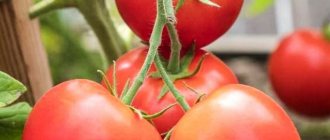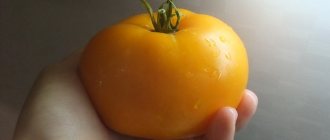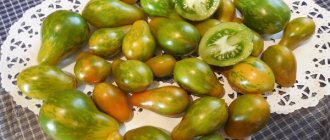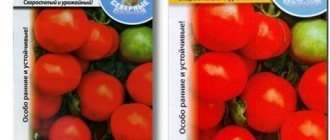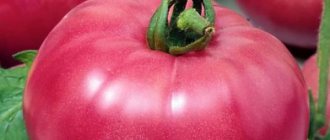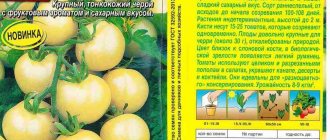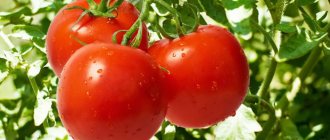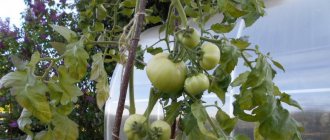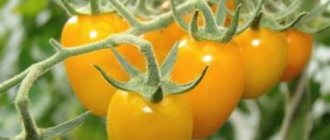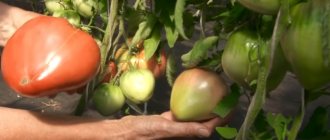The Adeline tomato is well cultivated in open ground because it is practical and adapts well to different weather conditions. In many regions of Russia, gardeners are forced to grow high-quality tomato varieties only in greenhouses due to the cold climate. However, if this is not possible, you should pay attention to this variety. Its fruits have a universal purpose and are delicious. However, in order to achieve high yields, you need to strictly follow the cultivation techniques.
Tomato Adeline is unpretentious in care, tolerates low temperatures and prolonged drought well
Description of tomato variety Adeline
This is a low-growing, mid-season variety of determinate type; the plant reaches a height of no more than 45-50 cm. The bushes are powerful with a strong stem, sparsely leafed or have an average amount of bright green foliage. Due to its small stature, the Adeline bush does not require formation; however, it requires tying to a support, since under the weight of the fruit the stems of the plant break or fall to the ground.
After the fifth leaf, the first flower cluster grows on the stem, the next one is formed after two leaves. In total, no more than five brushes develop on the stem. They bear 7-8 fruits.
From the moment the first shoots appear until the start of harvesting, under favorable conditions, 110-120 days pass. The Adelina variety is included in the State Register of Russia for the North Caucasus, however, the crop can be grown throughout the country. And although the Adeline tomato is intended for cultivation in open ground, when grown in a greenhouse, productivity indicators are not lost, however, the bush becomes longer.
Description of fruits
The fruits have a universal purpose because they are small in size and have thick skin. The average weight of one Adeline tomato reaches 60-95 g; it has an oblong ovoid shape.
The shiny, smooth skin of ripe fruits has a bright red color.
The shiny, smooth skin of ripe fruits has a bright red color.
Inside there are six chambers with a small number of seeds, the flesh is dense, fleshy and juicy, with a sour-sweet taste.
Disease resistance
The Adeline tomato belongs to a heat-resistant variety, for which high air temperatures and low humidity levels are preferable. In sunny weather, the plant develops well, which increases its resistance to various microorganisms, including various types of rot. The tomato does not tolerate increased humidity, as a result of which the seedlings are at risk of being affected by the mushroom stalk. And an abundance of prolonged heavy rains can cause a disease such as late blight in an adult plant. Therefore, timely prevention in the form of spraying the plant with special means will only benefit it.
Characteristics of tomato Adeline
The Adeline tomato is a cold-resistant variety and easily tolerates temperatures dropping to almost 0 °C, while continuing to actively bear fruit. Therefore, the variety is ideal for cultivation in the conditions of Siberia and the Urals. In addition, Adeline bushes also tolerate hot days well and do not wither for a long time in dry weather, and the fruits do not lose their presentation.
Adeline tomato yield and fruiting
Under favorable conditions, this variety is characterized by medium ripening periods. And the growing season is 110 to 120 days. The Adelina tomato is considered one of the highest-yielding low-growing varieties. From one bush you can collect up to 4 kg of ripe tomatoes in open ground.
Attention! With an excess of nitrogen fertilizers, the yield of the Adeline tomato is significantly reduced, since the fruits set poorly.
If you provide the bushes with proper care, you can collect up to 25 kg of fruit from 1 square meter. m
The productivity of the bushes is influenced by the fact that the Adeline tomato is particularly sensitive to soil moisture and air humidity. Therefore, if the summer is rainy and windy, the harvest will be lower. Under greenhouse conditions, achieving maximum performance is a little more difficult, since the crop is intended for cultivation in open ground.
Area of application of fruits
Tomatoes are universal, have a good taste, so they can be eaten both fresh and in the form of salads and fresh juices. You can prepare various sauces from them, add them to soups and stews. In addition, the small size and dense structure of the skin make it possible to preserve whole fruits or pickle them for the winter. The fleshy pulp is well suited for marinating in pieces, preparing tomato paste, and all kinds of dressings.
Resistance to diseases and pests
The Adeline tomato has high resistance to various microorganisms and fungal infections, including many types of rot. But since the plant is sensitive to high humidity, with excessive watering it can be affected by fungal stem or late blight.
Timing of sowing seeds
The average ripening time for Adeline tomatoes is from 110 to 120 days from the appearance of the first shoots. To obtain high-quality and strong seedlings, it is necessary to sow the seeds 65 days before planting in the soil. The average age of seedlings should be at least 40-45 days, that is, it is worth sowing seeds for seedlings in the middle zone no earlier than mid-March. It is necessary to plant strong and hardened seedlings into the soil in the last ten days of May.
Description and characteristics of the Ataman grape variety, history and cultivation rules
Advantages and disadvantages of the variety
The Adeline tomato has many advantages and virtually no disadvantages, which is why farmers prefer this crop for growing over large areas on an industrial scale.
pros
- frost resistance and drought resistance;
- high productivity;
- friendly ripening of fruits;
- gastronomic qualities and presentation;
- the ability to cultivate in open ground;
- good resistance to disease and rot;
- versatility of fruit use;
- transportability and keeping quality.
Minuses
- does not grow well in high humidity conditions.
Reviews
Adeline created a real sensation on the agricultural crops market. The variety confidently competes with similar varieties of tomatoes, leading in taste, appearance of fruits and yield. Gardeners praise Adeline; there are no bad reviews about tomatoes. It is advised to grow tomatoes in open ground; they say that the yield and taste characteristics do not suffer. Many gardeners say that tomatoes travel well and do not wrinkle. Adeline can be found on sale at the market.
The Adeline tomato variety continues to spread rapidly throughout Russia. It belongs to the variety that does not require special care, no matter what happens to the bush, the tomatoes will grow tasty and beautiful in any case. The variety is suitable for growing by inexperienced gardeners, as there will definitely not be any problems with it.
Features of cultivation
To grow seedlings at home, you can use special containers or improvised containers. In both cases, the container must be treated with a weak pink solution of potassium permanganate to disinfect it. It is also important to pre-prepare planting material.
Planting seedlings
Adeline seeds need to be sorted out and left only developed ones, without visible damage. They should be immersed in a 25% solution of potassium permanganate for 15 minutes. If the seed is purchased in specialized stores, this is not done at all; the seeds have already been processed. You can purchase soil or prepare it yourself. To do this you need to mix the following ingredients:
- 1 portion of river sand;
- 1 portion of compost;
- 7 servings of peat.
Before sowing, the prepared substrate must be calcined and cooled.
Important! It is necessary to disinfect the seed material and calcine the substrate on the day of sowing.
Seeds begin to be sown in early March. To do this, they are buried 2 cm into the soil, at a distance of 3 cm from each other, watered and covered with film. After about 7-10 days, sprouts appear, which need to be provided with sufficient light, otherwise they will stretch, intertwine and fall. After 2-3 true leaves have appeared, the seedlings are planted in separate pots.
Transfer
Young plants can be planted when they reach a height of 15 cm. Before planting seedlings in open ground, it must be prepared. To do this, for 1 sq. m of bed intended for tomatoes, add a bucket of compost and dig it up. Planting scheme for tomato seedlings Adeline - 60x60 cm, time - mid-May.
After planting in open ground, plants must be watered abundantly.
They begin to plant seedlings in a greenhouse from the beginning of May; in the southern regions it is permissible at the end of April.
Aftercare
Adeline tomato seedlings require regular but moderate watering. Settled water at ambient temperature. Optimal watering is once a week, if the weather is hot - once every five days.
Tomatoes are fed with complex fertilizers no more than once a month. During the period of fruit set and active growth - once every three weeks.
The bushes do not require pinching; however, the stems must be tied to pegs during the period when clusters with heavy fruits form on them.
Ripening tomatoes
With timely planting of seedlings and good care conditions, the first harvest of tomatoes can be harvested in the second half of July, enjoying the sweetish taste of the aromatic fruits. An equally important factor is weather conditions - in dry and hot weather, the crop will ripen earlier than in cool and rainy periods. When fully ripened, which proceeds quite smoothly, the tomatoes acquire a scarlet color.
Cherry tomatoes on the windowsill, at home: how to grow tomatoes quickly and easily? Tips and tricks for beginners (105 photos)
Pest and disease control
To prevent plants from getting sick, it is necessary to weed the beds in a timely manner, removing weeds, and spray for preventive purposes:
- for cladosporiosis - once every 10 days with a solution of copper oxychloride;
- against phomosis and late blight – with a solution of “Fitosporin”;
- against aphids - once a week with a soap solution (1:6).
In addition, to avoid soil acidification, it is necessary to regularly loosen the beds with tomatoes - this will reduce the risk of fungal infection.
Tomato care
In addition to fertilizing with mineral fertilizers, which should be stopped shortly before the tomatoes ripen, it is necessary to loosen the soil. This will provide the root system with not only access to oxygen, but also the necessary nutrients that come in the form of biological products when feeding. When fruits are forming, it is recommended to add diluted ash to the soil. To do this, you need to dilute 50-70 g of ash in 10 liters of water and let it brew for 4-5 days. Watering is recommended in the evening.
Tomato
In search of a good tomato variety for universal use, you should take a closer look at the Adeline tomatoes. The plant is easy to care for, will not be difficult to grow, and the number of tomatoes grown will greatly please you.
Characteristics and description of the variety
Tomatoes of the Adeline variety can be grown both in open ground and in greenhouse conditions. The tomato bush has good frost resistance and is able to bear fruit at temperatures close to zero. Tomatoes are suitable for cultivation in any area; they can be easily grown in Siberia and the Urals.
The standard bush reaches a height of half a meter. The bush requires tying to a trellis or any support. “Adeline” is a determinate variety of tomatoes; the formation of clusters begins above the sixth leaf.
There are few leaves, the bush is powerful. Fruiting occurs in mid-summer and lasts until August. During this time, beautiful, neat, elongated fruits ripen on the bushes.
During the season, 4 kilograms of fruit are collected from one square meter.
Tomatoes have an attractive appearance. Tomato weight is from 90 to 110 grams. The rich red skin shines in the sun and protects the fruit from cracking and dents.
The pulp contains a lot of juice and a small amount of seeds. The taste is mixed, sweet and sour.
The universal taste allows tomatoes to be used for various purposes: they are cut into salads, canned, used to make tomato juice and puree.
Tomatoes of this variety are distinguished by their ability to resist many diseases characteristic of crops of this kind: late blight, fusarium, rot. The variety tolerates dry and hot weather well, while the leaves do not wither for a long time, and the fruits do not lose their appearance.
Adeline has earned the trust of many gardeners. The variety is distinguished for the following positive qualities:
- smooth, beautiful fruits with durable skin;
- universal purpose of tomatoes;
- undemanding to soil when growing;
- drought resistance;
- compactness of tomatoes;
- possibility of planting in open ground;
- developed immune capacity.
Growing and care
Like all tomato varieties, cultivation begins with planting seeds. Tomato seedlings are planted no later than mid-March. Typically, landing time is in the middle, end of February or early March.
Seeds are purchased in the store, it must be in the packaging material. To plant seeds, you can use soil brought from your summer cottage. The soil is pre-treated with a solution of potassium permanganate.
The seeds are also briefly soaked in potassium permanganate to prevent contamination.
Important! Treatment of seeds and soil is carried out on the day of planting.
After the soil and seeds have been processed, planting begins. The grains are pressed slightly into the ground and left to germinate. Water the container with the planted seeds with water and cover with cling film. A week after planting, sprouts will appear. Continue to care for hatched tomatoes: moisten the soil as it dries, and keep the film closed.
https://www.youtube.com/watch?v=yXlnibwgUhE
You may be interested in:
When the seedlings have grown a little and are in the phase of developing the second leaf, pick them. For diving, containers of 300-400 milliliters in size, which are filled with earth, are suitable.
You can add one part of humus and peat to the soil. After diving, the seedlings are placed in a sunny place, perhaps on a windowsill, and allowed to strengthen properly.
When the height of a tomato bush reaches 15 centimeters or more, it can be transplanted into a greenhouse or outside.
Planting in a greenhouse is carried out no earlier than May, and in open ground - from the middle of the month. The exception is the southern regions, where summer comes much faster. Adeline is considered a frost-resistant variety, so there is no need to worry about the tomatoes after transplanting. They will quickly get stronger and continue to grow rapidly. Immediately after transplanting, the tomatoes are tied to a trellis or support.
Adeline prefers moderate watering, but does not tolerate waterlogging of the soil. Watering with ice water will cause rotting of the root system, and the tomatoes may die. The same goes for overwatering. When watering, you can add chicken manure and saltpeter at the beginning of growing tomatoes. Before flowering, add potassium salt. During fruiting, refrain from watering and using additives.
The holes where tomato bushes grow are regularly kept clear of extraneous grass and weeds, and the soil is loosened to enrich it with oxygen.
Attention! The holes can be mulched with sawdust and straw to protect them from frost and drought. When growing in greenhouses, do not forget to ventilate the greenhouse: open the windows and doors, and close them at night.
Harvesting
Tomatoes are harvested from the plant when most of the fruits are red or pink. Green tomatoes can also be picked, but in this case they need to ripen. Tomato ripening takes from one to two weeks.
The tomatoes are placed in a dry, warm place and left to lie, turning them over periodically.
After a few days, the color of the skin will change from green to red, and the taste of the tomatoes is no different from those that were picked ripe from the bush.
Fresh tomatoes are stored on average for no more than 3 weeks. It is better to store tomatoes in the refrigerator; green fruits should be stored indoors. Overripe tomatoes are eaten immediately; they spoil quickly.
Tomato Adeline: 7 features and 12 tips for growing and caring
I have been planting Adeline tomatoes for more than 5 years, and every year they please me with a stable harvest without special care. In the review, I will tell you about all the features of this option and share my experience in growing seedlings and caring for adult plants.
What you need to know about this variety
Characteristics and description of the variety:
- Brought out by domestic breeders and included in the State Register of Plants of the Russian Federation for the North Caucasus region. But it is successfully grown almost throughout the country. Intended for cultivation in open ground, but is cultivated in greenhouses and under film covers.
- Bushes of determinate type, up to 50 cm high . When grown in a greenhouse, plants can stretch up to 70-80 cm. The crown is compact and does not require pinching. The first flower raceme appears above the 5-6th leaf, then forms through the leaf. Staking is required, as the weight of the fruit causes the plants to fall to the ground.
- Productivity is up to 2 kg per bush, on average 4 kg per square meter in open ground. In a greenhouse, the yield is much higher. For best performance, plants should be well lit by the sun and fed on time.
- The variety has a mid-early ripening period; from the moment of germination to harvest, it takes from 95 to 110 days. The fruiting period is about two months.
- The average fruit weight is from 60 to 90 g . They have an oval or plum-shaped shape and a dense, rich red skin. The tomatoes are juicy, but at the same time quite dense, so they tolerate transportation well and are stored well.
- The taste is excellent . Tomatoes are suitable for fresh consumption, as well as for any preparations. Due to its small size and shape, this option is ideal for whole-fruit canning.
- The variety is resistant to fusarium and late blight . Resistance to other diseases is average.
Tomatoes are small and dense, so they remain fresh for a long time
In the video, the gardener talks about all the features of the variety, paying special attention to the fact that many tomatoes ripen on the bush at the same time.
:
How to grow seedlings
| Stage 1. Purchase of planting material Step 1. Calculate the approximate number of seeds that are needed. Take with reserve, as most often not all of them sprout. After ripening, you can collect planting material yourself so as not to buy it for next year. Step 2: Purchase seeds from a reputable store. Avoid street vendors and stalls |
| Stage 2. Disinfection Step 1. Prepare a solution of potassium permanganate, as in the photo. It shouldn't be too rich. Mix the liquid well until the crystals dissolve completely. Step 2. Wrap the seeds in a bandage so as not to catch them from the solution. Place in container and let sit for 15 to 20 minutes. Then remove and rinse in warm water |
| Stage 3. Treatment with a growth stimulator Step 1. Buy a growth stimulator, there are many options, almost everything works. I recommend Epin - an inexpensive and proven remedy that is popular with many gardeners. Step 2. Study the instructions on the package and prepare the solution according to its instructions. Dip the seeds into it and wait the required time. Then remove and dry |
| Stage 4. Sowing seeds Step 1. Prepare a container; it can be either a special container or a handy container of a suitable size. Purchase ready-made soil for seedlings. Step 2. Pour the soil into the container in a layer of about 5 cm, make small grooves, as in the photo. Place the seeds every 2-3 cm. Cover with a layer of soil no more than 10 mm and water. Step 3. Place in a warm place and water as the surface of the soil dries. After germination, transfer to a windowsill or other place with good lighting. |
| Stage 5. Picking Step 1. When two or more true leaves form on the plants, the plants should be planted in a separate container. To avoid diving twice, choose containers with a volume of 0.5 to 1 liter. Fill with soil and make a hole in the middle. Step 2. Carefully dig up the sprout with soil and transplant it to a new location. Compact the surface well and water thoroughly |
| Stage 6. Caring for seedlings Step 1. Spray the plants with warm water in the morning and evening, use a household sprayer. Water as the soil dries out, usually once a week is enough. Step 2. 2-3 weeks after picking, apply complex fertilizer for seedlings. Step 3: Start hardening off the plants 10 days before planting. Take them outside on warm days or leave them near an open window. |
How to care for tomatoes
| Stage 1. Landing Step 1. Apply compost or rotted manure to the tomato plot at the rate of a bucket per square meter. Spread evenly over the surface and dig up the bed. Step 2. Dig holes for the plants according to a 60x60 cm pattern. Carefully remove the container from the tomato so as not to damage the soil ball. Place in the hole, cover with soil and compact the surface. Water thoroughly |
| Stage 2. Watering Step 1. The day before work, pour water into containers and place them near the garden bed or in the greenhouse. During this time, it will settle and warm up to the ambient temperature. Step 2. Water the tomatoes in the evening after sunset. The optimal frequency is approximately once a week. During hot periods, water the plants once every 5 days |
| Stage 3. Loosening and weeding Step 1. Remove weeds from the garden once a week. While they are small, this is easy to do. Plus, they will not take away the nutrients needed by tomatoes from the soil. Step 2. Loosen the surface around the tomatoes after each watering. If the bed is outside, then cultivate the soil after rains |
| Stage 4. Feeding Step 1. Purchase a complex composition for tomatoes. It can be a mineral fertilizer, as are the options based on organic substances. Step 2: Feed your tomatoes once a month. During the fruiting period, fertilizer can be applied every 3 weeks to ensure maximum yield. |
| Stage 5. Tying Option 1. Drive a peg into the ground near each bush. Tie the stem to it in 1-2 places so that it does not bend under the weight of the tomatoes. Option 2. Secure a crossbar over the plants, ropes are tied to it above each bush. They are lowered onto the stem, wrapped around it and fixed at the bottom |
| Stage 6. Timely harvesting Step 1. Pick tomatoes as they ripen. Do not overexpose them to the plant so that they do not take away nutrients. Step 2. Remove all damaged and rotting fruits from the garden |
Diseases and pests
| Cladosporiosis Prevention: weeding and cleaning the area from dried leaves. Treatment with Fitosporin once every 2 weeks. Control : spraying with copper oxychloride solution every 10 days |
| Fomoz Prevention: maintaining normal humidity, ventilating the greenhouse. Control : removal of damaged fruits from the site. Spraying with Fitosporin solution |
| Aphid Prevention: avoiding waterlogging, timely weeding and loosening. Control: spraying plants with a solution of laundry soap once a week |
Why are there no tomatoes?
- Seed infection. Be sure to disinfect them with potassium permanganate before planting.
- Lack of nutrition. Without nutrients, the ovaries may fall off.
- Excess nitrogen in the soil. It causes the stems to grow, and the yield drops significantly.
Reviews from gardeners
Yakov, Krasnodar region
I don’t know who it was, but for me the black leg appeared after transshipment, when the plants grew and the root zone ceased to be sufficiently ventilated due to neglect.
Eva, Moscow region.
They were declared as standard ones and which do not need to be pinned, they were declared up to 60 cm, but mine grew 1 m. All these tomatoes had to be pinched because... it would be a jungle
Adelina - 3-4 tbsp, all fruits are even, the same size, up to 100g, red, very productive.
Tomato Adeline: characteristics and description of the variety, photos and reviews of the yield of those who planted tomatoes
Tomatoes have become a part of our daily lives. They are used to prepare vegetable salads, soups, add to main courses, make ketchups, sauces, pickle, and eat fresh. The scope of application of this unique and very useful vitamin vegetable is increasing at incredible speed. One of the most suitable varieties for pickling and preparing for the winter is “Adeline”.
Description of the variety
The Adeline variety is distinguished by its unpretentiousness and versatility. The low-growing stem stops growing after the formation of 4, sometimes 5 brushes, which makes caring for the crop easier. The tomato is mid-season. The height of the stem does not exceed 40-50 cm.
The leaves of the plant have a bright green color. The oblong red fruits are small in size with a dense skin, fleshy pulp, which is characterized by a sweet and sour taste. Their weight often does not exceed 100 g, which is a huge advantage for supporters of vegetable preservation.
The average yield is about 3-4 kg per bush.
What makes berries happy?
Summer residents fell in love with the delicious fruits. They are ready to wait a little: at the end of July, the variety will give baskets of fragrant berries. Characteristics of tomatoes:
- smooth;
- have the shape of an egg;
- the fruit reaches 95 g;
- the flesh is fleshy, juicy;
- taste sweet and sour;
- ripe tomatoes are bright red;
- 6 chambers with small seeds;
- “tomato” aroma;
- thick skin.
Those who planted the variety know: Adeline pleases with the universal purpose of the fruits. They are delicious fresh and do not crack during heat treatment. The peel does not spoil the juice or paste. The pulp does not spread in vegetable slices.
Characteristics of tomato
The Adelina tomato variety is a suitable option for those who do not have enough time to care for the garden.
Main qualities:
- heat resistance of the plant;
- high resistance to diseases and rot;
- good yield;
- versatility of fruit use;
- unpretentiousness in cultivation and care;
- good tolerance to lack of moisture during dry periods;
- intended for cultivation in open ground.
Advantages and disadvantages
Among the main advantages it is worth noting its endurance to high temperatures, which contributes to good ripening of fruits.
Due to the presence of a low stem, the bushes do not require staking and pinching, since they belong to determinate varieties, that is, they stop growing at a certain period of development.
To obtain a higher yield, you can tie them up, forming a bush of 2 stems. Dense and juicy fruits are great for any type of processing - pickling, pickling, making salads.
Among the disadvantages of the variety is sensitivity to heavy rainfall and excessive watering, as a result of which the plant can be infected with fungal bacteria.
Tomatoes "Adeline": advantages and care
Tomatoes are firmly established in our daily lives. They are marinated, made into sauces, ketchups, added to main courses, prepared in soups, vegetable salads, and consumed fresh. The scope of application of this useful and unique vegetable is increasing at incredible speed. The most suitable variety for winter preparation and pickling is the “Adeline” variety.
Features of the variety
"Adeline" is a low-growing, determinate, mid-season tomato, suitable for film shelters and open ground. The bushes have a height of 0.4 - 0.5 m; pinching is not required. The bushes need to be tied to a support. The first inflorescences are laid above the 5th - 6th leaf, and the subsequent ones appear every one - two leaves.
The fruits are smooth, have the appearance of oval cream, and become red when ripe. Weight from 60 to 90 g, tasty, juicy. The variety is resistant to fusarium; the fruits set well even in dry, hot summers.
Usage
In cooking, Adelina tomatoes are used in preparing vegetable salads. The fruits are suitable for making sauces, tomato pastes, and canning.
Source: https://AgroEvropa.ru/drugoe/tomat-adelina.html
